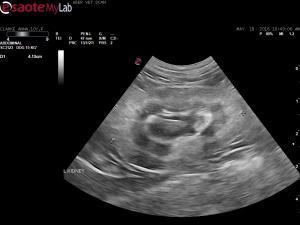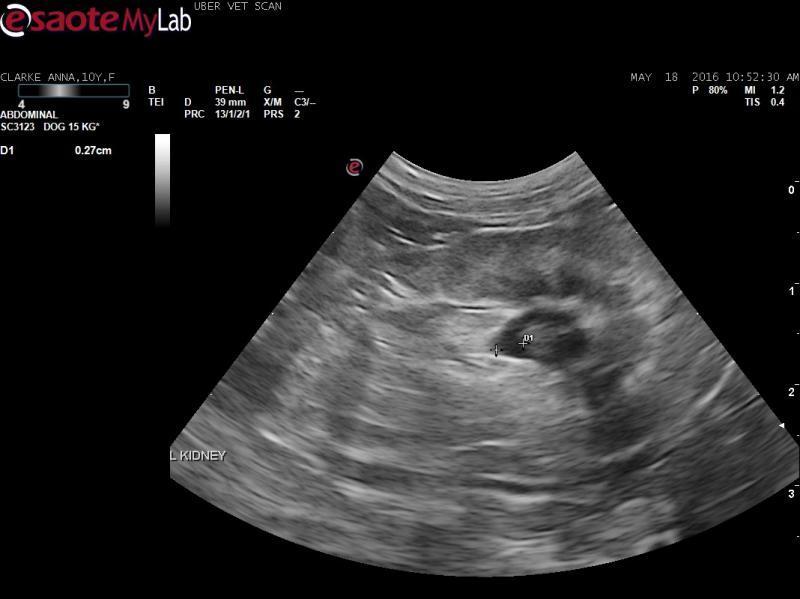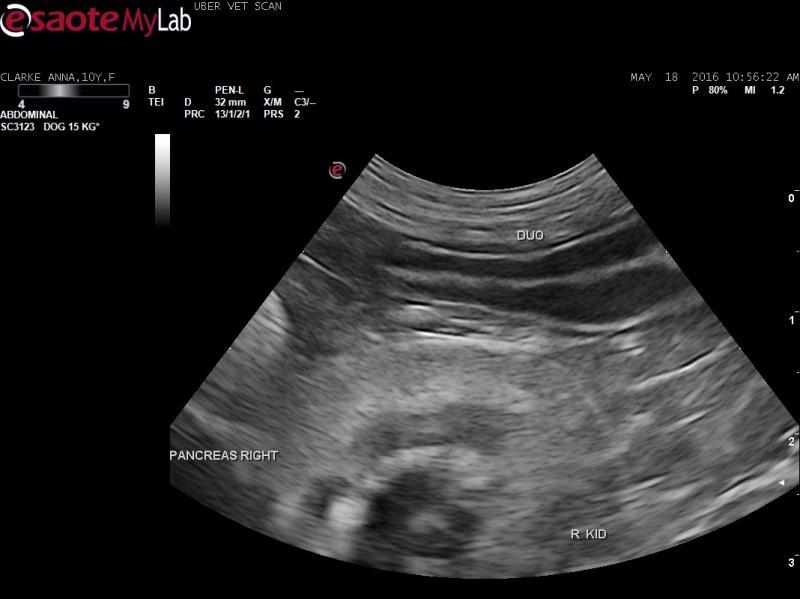– 10 year old FS Chihuahua with waxing and waning symptoms of lethargy, poor appetite, vomiting and sore abdomen
– bloodwork consistent with renal failure, mild anemia, hyperphospatemia, hypercalcemia; mild elevation ain ALP, other liver parameters normal
– SNAP cPLI has been positive and rDVM worried about possibility of pancreatitis with renal failure
– u/s shows fairly normal pancreas (so cPLI may be false positive due to azotemia or gastritis)
– the renal cortices are thick, quite hyperechoic and there is a meduallary rim sign and pyelectasia
– 10 year old FS Chihuahua with waxing and waning symptoms of lethargy, poor appetite, vomiting and sore abdomen
– bloodwork consistent with renal failure, mild anemia, hyperphospatemia, hypercalcemia; mild elevation ain ALP, other liver parameters normal
– SNAP cPLI has been positive and rDVM worried about possibility of pancreatitis with renal failure
– u/s shows fairly normal pancreas (so cPLI may be false positive due to azotemia or gastritis)
– the renal cortices are thick, quite hyperechoic and there is a meduallary rim sign and pyelectasia
– rDVM has not performed a urine pro:cre ratio nor BP (has been recommended)
– pet has been on Fortekor, Clavaseptum, famotidine, at home SQ fluids and phosphate binder, Cerenia
I would call this an interstitial nephrosis pattern which goes with renal failure on lab work – could Lepto do this? Lyme nephritis? Toxin? End-stage kidney disease of unknown cause?



Comments
Hey Jackie
Can’t comment on
Hey Jackie
Can’t comment on the images but I have learned that the snap lipase although a qualitative color test, it can be quantified. We have the snap reader that often indicates it is positive so we have our tecnicians visually determine the degree of color change. Idexx says that mild color change is normal or slight increase, and a significantly darker change is more significant and more likely to be a high number. So we see alot of our snap lipases that are positive by the snap reader but are not significant because there is minimal color change.
Have a great weekend. Brent
Thanks Brent. It is a nice
Thanks Brent. It is a nice test to have in clinic for a rapid assessment but agree it has it limitations. I’m not sure “how blue” this test was as it was done at another clinic and I just got a report of positive from the history. You bring up a good point. I do prefer getting an actual number from the lab if possible for sure.
As for the new Antech PSL test – not sure how to trust this at all as we seem to be getting at least an 80% elevated rate on routine wellness testing in pets with absolutley no signs of pancreatic disease.
Happy May 2-4!
With the hypercalcemia and
With the hypercalcemia and rim sign would also think of hypercalcemia of malignancy with secondary renal disease. Pylonephritis also possible which may be primary or secondary. Pancreas looks normal so elevated cPLi secondary to azotemia/gastritis
Remember the GI produces
Remember the GI produces Lipase (not just the pancreas) and as of yet I have not heard of a study that has scupulously looked at false + CPL but we see them all the time. Remo anything new on this?
Pancreatitic lipase is only
Pancreatitic lipase is only produced by the pancreas and thus elevated levels are indicative of pancreatitis. However, elevated levels have been reported with IBD, hypertriglyceridemia, and diabetes without overt pancreatitis. Ideally the SNAP cPLi should be follwed up with the Spec cPLi to quantify the acutal concnetration.